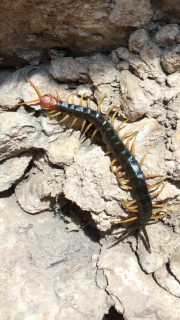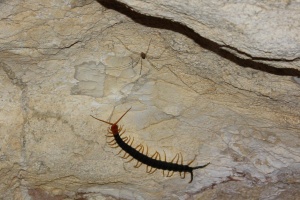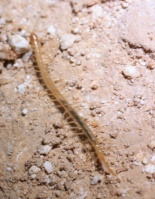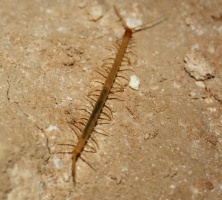Invertebrates (Inventory)/Centipede
From LagWiki
(New main image) |
(Added a new primary image) |
||
| (10 intermediate revisions not shown) | |||
| Line 1: | Line 1: | ||
| - | {{Inventory image|File:Centipede. | + | {{Inventory image|File:Centipede.PNG|Centipede}} |
| - | The '''Centipede''' field of the [[Invertebrates (Inventory)|Invertebrates]] section should list stations where | + | The '''Centipede''' field of the [[Invertebrates (Inventory)|Invertebrates]] section should list stations where a centipede is found. |
| - | Centipedes | + | Centipedes have flat, multi-segmented bodies, with each segment having only one pair of legs. The total number of legs varies, but there are usually 20 or more. They are arthropods, not insects. Centipedes are predators and have 2 pincers just behind the head. Their bite is painful (like a bee sting), but not fatal. Some centipedes are known to prey on bats. They move very quickly and can be quite large and can climb well. The size can vary from small (an inch or less) to several inches in length and up to an inch in width. The color can vary from unpigmented to brown, dark brown or rust. Centipedes should not be confused with [[Invertebrates (Inventory)/Millipede|millipedes]] which have two pairs of legs per body segment. |
| - | + | ||
| - | + | ||
| - | + | ||
| - | + | ||
==See also== | ==See also== | ||
*[[Invertebrates (Inventory)/Millipede|Millipede]] | *[[Invertebrates (Inventory)/Millipede|Millipede]] | ||
| + | |||
| + | ==References== | ||
| + | *Romero, Aldemaro (2009) ''Cave Biology; Life in Darkness'' Cambridge University Press, New York pp 106-107 ISBN-Hardback: [[Special:Booksources/978-0-521-82846-8|978-0-521-82846-8]], ISBN-Paperback: [[Special:Booksources/978-0-521-53553-3|978-0-521-53553-3]] | ||
| + | |||
| + | ==Centipede, Invertebrates== | ||
| + | <gallery perrow=2 widths=300px heights=200px> | ||
| + | File:Centipede and harvestman.JPG|Centipede and [[Invertebrates (Inventory)/Harvestman|harvestman]] on the ceiling | ||
| + | File:Centipede.jpg|Centipede | ||
| + | File:Centipede_2.JPG|Centipede | ||
| + | </gallery> | ||
{{Cave inventory}} | {{Cave inventory}} | ||
| - | |||
| - | |||
Current revision as of 02:25, 16 November 2015
The Centipede field of the Invertebrates section should list stations where a centipede is found.
Centipedes have flat, multi-segmented bodies, with each segment having only one pair of legs. The total number of legs varies, but there are usually 20 or more. They are arthropods, not insects. Centipedes are predators and have 2 pincers just behind the head. Their bite is painful (like a bee sting), but not fatal. Some centipedes are known to prey on bats. They move very quickly and can be quite large and can climb well. The size can vary from small (an inch or less) to several inches in length and up to an inch in width. The color can vary from unpigmented to brown, dark brown or rust. Centipedes should not be confused with millipedes which have two pairs of legs per body segment.
See also
References
- Romero, Aldemaro (2009) Cave Biology; Life in Darkness Cambridge University Press, New York pp 106-107 ISBN-Hardback: 978-0-521-82846-8, ISBN-Paperback: 978-0-521-53553-3
Centipede, Invertebrates
Centipede and harvestman on the ceiling |
|




